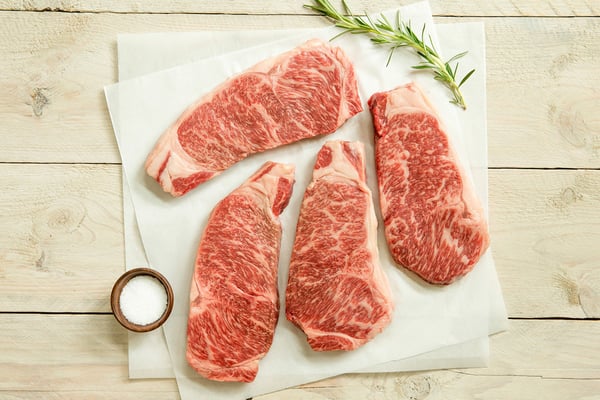
Youth isn’t always something to strive for. Similar to cheese and wine, quality beef is worth waiting for, and aging is a crucial step that ensures meat is as tender and flavorful as possible. The two main ways to age meat are dry-aging and wet-aging. Humans have been dry-aging meat for centuries, but wet-aging only became possible upon the invention of plastic and the magic of vacuum-sealing.
Dry-Aged vs. Wet-Aged: The Face-Off of Our Time
A battle for the ages. Both dry-aged and wet-aged steaks are worth trying, but they each have their pros and cons. The dry-aging process involves hanging cuts of meat just above freezing for weeks to allow enzymes to break down the collagen between muscle fibers, making the meat tender. This process also allows water to evaporate, which condenses the meat and concentrates the flavor. The concentrated flavor of dry-aged meat either attracts or repels people, depending on their tastes—it could be considered the blue cheese of beef. One downside of the dry-aging process is that the moisture loss shrinks the meat, resulting in a lower yield and higher cost per pound. Not to mention the further loss due to the need to “face” each cut, slicing the outer crust off each side to pass USDA standards.
The more common aging method used today is wet-aging, a process in which meat is vacuum-sealed in plastic and allowed to age for 4-10 days, or sometimes longer. Similar to dry-aging, the process allows enzymes in the trapped juices to break down collagen between muscle fibers, increasing tenderness. Unlike with dry-aging, there is no moisture loss, resulting in less concentration but making it more affordable and juicier with a higher yield. Wet-aged meat has a fresher, slightly metallic taste, which we’ve become accustomed to as dry-aging becomes a rarity.
Best Cuts for Each
Dry-aged
- Thick, marbled cuts like porterhouse
- Bone-in ribeye
- Bone-in strip steak
Wet-aged
- Boneless strip steak
- Filet mignon
- Flat-iron steak
- Flank steak
Best Ways to Prepare
Aged meats can be cooked on either the grill or the oven; just be sure not to overcook the cut in either case. The point is to appreciate the tenderness and flavors created by the aging process, so keep it simple.
Especially with dry-aged meat, let the thawed steak sit at room temp for 30-60 minutes to allow it to “unfold.” For wet-aged steaks, you will also want to pull the meat out of the fridge 30 minutes before you’re ready to cook so it can reach room temperature. Add minimal seasoning—a bit of salt will do. Then roast or grill the meat to preferred doneness—we recommend no more than medium-rare.
Once your meat is ready to cook, follow these steps for grilling:
- Heat the grill to medium high.
- Sear each side for a minute or two. We're looking for the Maillard reaction and a crispy, caramelized coating. For a rare finish, sear for three minutes per side. For a medium-rare sear, aim for four minutes per side.
- Check for doneness by using the touch test or a meat thermometer. Whichever method you choose, shoot for medium-rare or 130°F.
- Move the steaks to a lower heat and cook for another 4-5 minutes.
- Remove the steaks and let them rest for at least five minutes but as much as 10 minutes before enjoying.
Dry-aged and wet-aged steaks are both worth a try. Both hold the wisdom and tenderness that come with time. Our Wagyu steaks are wet-aged for 56 days in their own juices for ultimate moistness and tenderness. We would argue that long-term wet-aging is the best of both worlds, allowing the meat to maintain moisture while giving it the time it needs to develop peak tenderness. If you want to taste what we mean, we recommend trying our wet-aged strip steaks, a thick, robust cut that demonstrates you can have your steak and eat it, too.





